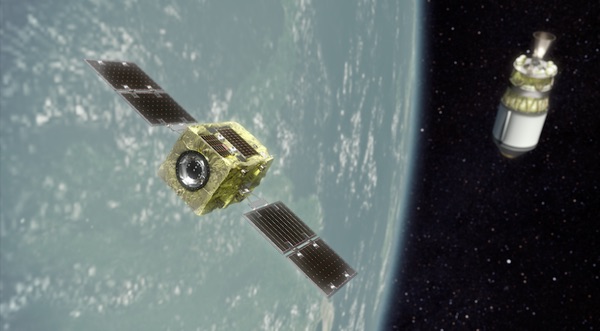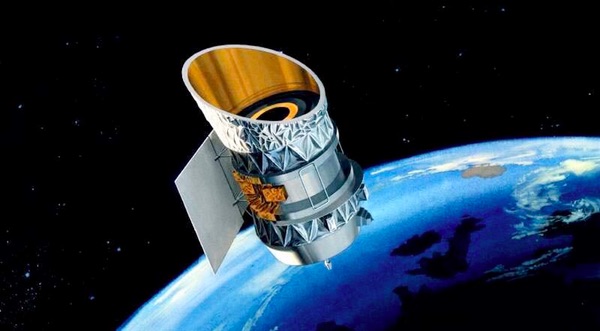Will we hit the snooze button on an orbital debris wakeup call?by Jeff Foust
|
| “Luckily there was no collision, but we used that to talk about how a lot of the derelict satellites and debris that are already up there are hazardous to one another, and it’s only a matter of time until we have a new cloud of debris in orbit,” said Ceperley. |
One of the satellites was the Infrared Astronomical Satellite (IRAS), a joint mission of the US and the Netherlands launched in 1983. The other was Gravity Gradient Stabilization Experiment (GGSE) 4, a technology demonstration satellite launched in 1967 and linked to the POPPY series of signals intelligence satellites (see “A flower in the polar sky: the POPPY signals intelligence satellite and ocean surveillance”, The Space Review, April 28, 2008). IRAS was heavy, weighing more than 1,000 kilograms, while GGSE-4 had a boom 18 meters long. The latter increased the chances of a collision while the former increased its consequences.
LeoLabs, a California company that operates a network of radars that tracks objects in low Earth orbit, first raised the alarm about a potential collision two days prior to the close approach, concluding there was a 1-in-100 chance of a collision. Hours before the impact, the company revised those odds to 1 in 20. And, since both spacecraft had been defunct for decades, there was no way for them to maneuver to avoid a collision. All anyone could do was watch and wait.
Fortunately, they missed. A few hours after the predicted close approach, both LeoLabs and the US Air Force said they saw no evidence of a debris-generating collision. “Taking into account the objects’ unique sizes and dimensions, it is reasonable to estimate that these satellites may have come within just a few meters of actually hitting each other,” LeoLabs concluded in a post-mortem about the conjunction published two days later.
“Luckily there was no collision, but we used that to talk about how a lot of the derelict satellites and debris that are already up there are hazardous to one another, and it’s only a matter of time until we have a new cloud of debris in orbit,” said Dan Ceperley, founder and CEO of LeoLabs, during a panel discussion a week later at the SmallSat Symposium in Mountain View, California.
He noted that LeoLabs was the first to publicly report the potential collision because the Defense Department currently doesn’t give notices of “derelict-on-derelict” collisions, as neither object has a means of avoiding a collision. Yet, such collisions could create large amounts of debris that would become a hazard to other satellites.
While the IRAS/GGSE-4 close approach attracted attention because of the characteristics of the objects and the high odds of a collision, it’s not a rare event. “This close approach between two objects was only one of five similar events during that day,” said Kevin O’Connell, director of the Office of Space Commerce, said in testimony before the Senate Commerce Committee February 12. “As challenging as the space debris problem is today, it is bound to grow more complex.”
That complexity, he noted, comes from satellite megaconstellations like OneWeb and SpaceX’s Starlink that will drastically increase the number of operational satellites in LEO. “This year alone, if SpaceX and OneWeb’s plans are successful, they will launch over a thousand new satellites into low Earth orbit, thereby increasing the number of active satellites by almost 50 percent.”
Some see last month’s near-collision as a way to raise awareness of the issue of orbital debris and options for cleaning it up. “I think this can serve as a wakeup call for us to look at not only avoiding collisions with active satellites, but also remediating, figuring out how to remove debris in orbit,” said Dan Oltrogge, director of the Center for Space Standards and Innovation at Analytical Graphics, Inc., in an interview prior to that close approach.
| “This close approach between two objects was only one of five similar events during that day,” said O’Connell of the IRAS/GGSE-4 near-miss. |
Oltrogge co-authored a paper presented at the International Astronautical Congress in Washington last fall that examined the risk of collisions, particularly among upper stages found in a few “clusters” in LEO. They modeled the collision of two upper stages in orbit at 981 kilometers, concluding it could create between 3,375 and 12,860 objects at least 5 to 10 centimeters in size, as well as more than 200,000 additional debris objects at least 1 centimeter across dubbed “lethal nontrackable” because they are large enough to damage or destroy a satellite but too small to be tracked.
Another co-author of that paper was Darren McKnight of Centauri, who made similar arguments in a presentation at the Advanced Maui Optical and Space Surveillance Technologies conference in September. He noted that, in May, two rocket bodies that are part of a cluster of such objects at an altitude of 850 kilometers passed within 87 meters of each other. “They’re big yellow school buses with no driver,” he said. “If they collide, it would have doubled the catalog population in one event.”
“The real solution lies in keeping the problem from getting worse,” said Ron Lopez, president and managing director of Astroscale U.S., the American subsidiary of Japanese company Astroscale, which is developing systems to remove satellites and other objects from orbit. He also cited the concerns about upper stages during the SmallSat Symposium panel. “If one of these things hits another large object, now you have tens of thousands, hundreds of thousands, of objects.”
 LeoLabs uses radars like this one in New Zealand, called the Kiwi Space Radar, to track objects in low Earth orbit. (credit: LeoLabs) |
Turning that wakeup call into action, though, is easier said than done. In June 2018, Space Policy Directive (SPD) 3 instructed the Commerce Department to take on the responsibility of civil space traffic management, a role currently held by the Defense Department. While DOD sensors would continue to provide data about the orbits of satellites, Commerce, through its Office of Space Commerce, would take over the role of issuing warnings about potential collisions, using the DOD data as well as that provided by commercial or international partners in what’s known as an “open architecture data repository.”
Commerce has slowly started that process, one hampered by a lack of funding. In its fiscal year 2020 budget request, the department sought to merge the Office of Space Commerce with the Commercial Remote Sensing Regulatory Affairs (CRSRA) office, which each received $1.8 million in 2018. The department sought $10 million for the combined office in 2020.
Congress, though, rejected both the merger of the two office and the budget increase. CRSRA got $1.8 million again while the Office of Space Commerce received $2.3 million, although that increase of half a million dollars was earmarked for an independent study on what agency should handle civil space traffic management work.
“It’s no secret that we did not get the budget that we requested for 2020,” O’Connell said at the Commercial Space Transportation Conference last month. “We’ll continue to do a lot of good work within the interagency, with our government colleagues, and we’ll be able to do some work with our allies.”
“What we’re less able to do is spend money in the market,” he said, by testing the capabilities of potential commercial data and analysis providers. However, he said his office will still get insights into those capabilities through partnerships those companies have with other agencies.
| “We do have good policies and practices in place,” Liou said, “but we are just not doing a very good job globally to implement those policies, practices, and requirements to limit the generation of orbital debris.” |
In its fiscal year 2021 budget proposal released last week, the Commerce Department is trying again. The proposal once again seeks to merge the Office of Space Commerce with CRSRA, and give the combined office $15 million. That additional funding would again go towards space traffic management work, including the open architecture data repository and hiring about a dozen people. “The bulk of our resource request in 2021 is for the space situational awareness mission,” O’Connell said at last week’s Senate hearing.
SPD-3 also directed government agencies, led by NASA, to update existing government guidelines for orbital debris mitigation. Those updated guidelines, though, published in December, made only modest changes to the original version published two decades ago, much to the disappointment of the those in the field.
The new guidelines leave intact what’s known as the “25-year rule” that calls for satellites in LEO to be deorbited no more than 25 years after the end of their missions. Many in the industry believe that is no longer sufficient given the growing population of satellites and debris. “When you were putting up 100 a satellite a year, maybe that was okay,” said Stanley Kennedy, president of Oakman Aerospace, at the SmallSat Symposium panel.
That wasn’t sufficient, he argued, in an era of megaconstellations. “There are people that are postulating that 25 is not the right number, but is it ten? Three? Two? Or, is it as soon as it dies you have to have a backup system that deorbits?”
The 25-year rule, though, still has its supporters. “The 25-year rule is still a good cost-benefit way for reducing debris,” said J.-C. Liou, chief scientist for NASA’s Orbital Debris Program Office, in a speech at the Second International Academy of Astronautics Conference on Space Situational Awareness in Arlington, Virginia, in January.
The problem was not the length of the rule, he argued, but compliance with it. While the 25-year rule has been widely adopted at the international level, Liou estimated that less than 50 percent of satellites complied with it. “We do have good policies and practices in place,” he said, “but we are just not doing a very good job globally to implement those policies, practices, and requirements to limit the generation of orbital debris.”
 Astroscale won a contract from JAXA to fly a mission to inspect and, later, deorbit a rocket stage left in low Earth orbit. (credit: Astroscale) |
Ultimately, any solution to the orbital debris situation will have to address deorbiting defunct satellites, like IRAS and GGSE-4, and spent upper stages. There has been some movement in that area. The European Space Agency awarded a contract in December to a Swiss startup, CleanSpace, to deorbit a payload adapter left in orbit from a Vega launch in 2013. Last week, Astroscale won a contract from the Japanese space agency JAXA for a mission to inspect an upper stage from a Japanese launch, a precursor for later deorbiting it.
“There’s a lot of interest and attention on this problem within Japan,” Astroscale’s Lopez said. “Japan is trying to position themselves as a thought leader in the area of space debris.”
He added, though, that the real business opportunity will come from operators of megaconstellations, who will be motivated to keep the orbits their satellites operate in free of debris, including their own defunct satellites. “There’s a solid business case behind owner-operators paying for debris removal services in order to de-risk their own orbits,” he said. “They’re going to be spending a lot of fuel avoiding their own satellites in order to not bump into them. That spent fuel translates into lost revenue potential.”
Satellite operators, though, may need some convincing. Iridium won praise when it deorbited its original fleet of satellites last year after completing the deployment of its next-generational constellation. However, 30 of those original satellites remain in orbit because they malfunctioned at some point after launch. Most of them will remain in orbit for at least a century, given their altitudes.
Matt Desch, CEO of Iridium, said he’d be willing to consider paying a company like CleanSpace or Astroscale to deorbit those satellites, for the right price. And what’s that right price? $10,000 per satellite, a figure even he acknowledged was unrealistically low.
| “In 2009, the Iridium/Cosmos collision served as a wakeup call for the entire space community to the threat that orbital poses to active satellites,” said Weeden. “Eleven years later, this most recent incident should serve as an alarm bell that there’s a lot more still to do.” |
“Matt sort of threw that number out to be a gadfly, to get some public dialogue on the issue going. He admitted that it was, in way, shape, or form, a realistic number,” Lopez said. “The point is that we as an industry need to get to the point to mature the technology, mature the business models, to come up with a business case and a price that makes sense. But I can tell you it’s going to be more than $10,000.”
There’s also the question of the role of Congress, either funding efforts like those at the Office of Space Commerce or passing legislation on related issues. Space situational awareness was the subject of a hearing by the House Science Committee’s space subcommittee February 11, and space traffic management was part of the hearing by the full Senate Commerce Committee the next day on “space missions of global importance” that also include planetary defense and space weather.
Neither committee, though, showed much interest of moving quickly on the issue. The House hearing was primarily an informational one, with witnesses discussing the current state of orbital debris and tracking efforts, as well as some of the legal and regulatory issues associated with them.
“In 2009, the Iridium/Cosmos collision served as a wakeup call for the entire space community to the threat that orbital poses to active satellites,” said Brian Weeden, director of program planning at the Secure World Foundation and one of the witnesses at the House hearing, comparing it to last month’s near-collision. “Eleven years later, this most recent incident should serve as an alarm bell that there’s a lot more still to do.”
However, committee leadership said they were only beginning to examine the issue. “Today’s hearing, and the testimony of our witnesses, is a critical start to exploring this topic,” said Rep. Kendra Horn (D-OK), chair of the subcommittee, citing language in a NASA authorization bill she introduced last month, HR 5666, that included provisions directing the agency to support research in space situational awareness (SSA) topics and debris removal. “The provisions in HR 5666 and today’s hearing are what I anticipate to be the first steps in a series of subcommittee and committee activities on space situational awareness.”
“SSA is an important topic for this committee to consider, but we should do so in a very deliberative manner,” said Rep. Brian Babin (R-TX), ranking member of the subcommittee. “Near-misses in space attract media attention and calls for draconian regulations, but overacting could be just as detrimental to our nation’s space enterprise.”
In the Senate hearing, O’Connell and Moriba Jah, a professor at the University of Texas who does research on space traffic management, got a positive reception from committee members. At one point, the committee’s chair, Sen. Roger Wicker (R-MS), used his phone to bring up AstriaGraph, a tool Jah developed to visualize objects in orbit.
But senators at the meeting were distracted. A series of votes were taking place on the Senate floor, causing senators to duck in and out. Sen. Kyrsten Sinema (D-AZ), ranking member of the committee’s space subcommittee, was at the hearing for only a few minutes, leaving before asking any questions. Sen. Ted Cruz (R-TX), chair of that subcommittee, never showed up.
| “I would hope that we could take this, and other conjunction events and close approaches, to try and get another look at active debris removal and other remediation techniques,” Oltrogge said. “But time will tell.” |
“I don’t know why the leadership does this to us,” Wicker complained at one point in the hearing, returning from the Senate floor after one of a series of votes. “Normally we wouldn’t have these until, say, noon or early afternoon, but for some reason it was deemed proper to have them at 10:30 today,” or half an hour after the hearing started. For much of the 90-minute hearing only a single senator was present.
Government and industry, then, risk hitting the snooze button on this latest wakeup call. “We could easily forget about this,” Oltrogge acknowledged when asked what would happen if IRAS and GGSE-4 didn’t collide. “This happens fairly regularly.”
“I would hope that we could take this, and other conjunction events and close approaches, to try and get another look at active debris removal and other remediation techniques,” he added. “But time will tell.”
Note: we are temporarily moderating all comments submitted to deal with a surge in spam.
